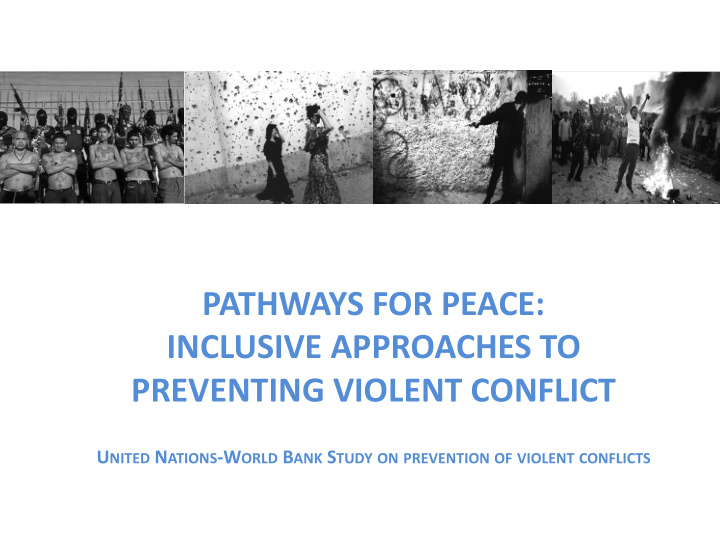



PATHWAYS FOR PEACE: INCLUSIVE APPROACHES TO PREVENTING VIOLENT CONFLICT U NITED N ATIONS -W ORLD B ANK S TUDY ON PREVENTION OF VIOLENT CONFLICTS
Violent conflict is becoming more complex Data Source: UCDP/PRIO Dyadic Dataset + UCDP Non-State Conflict Dataset
Objective of UN-World Bank Study To improve our understanding of how development processes interact with security, political, and human rights tools, to prevent conflicts from becoming violent. The study provides clear recommendations to governments and the international community on improvement of approaches to prevention of violent conflicts.
Methodology • Research based on existing data set and review of recent literature by the world’s leading research institutions on conflict. Close to 30 thematic papers. • 19 case studies of countries that have successfully managed to avoid violent conflicts despite high risk situations. • Very comprehensive program of consultations in Oslo, London, Stockholm, Berlin, Paris, Geneva, Amman, Cairo, Addis Ababa, Nairobi, Bangkok and Myanmar. Consultations at the UN and World Bank. • A high level steering committee and advisory committee.
Focus of the study • Recognizing the centrality of grievances around exclusion in modern violent conflict. • Violent conflicts build over a long period of time and in a non linear way • Most successful prevention is endogenous, undertaken by local/national actors and through the internal political process. International actors need to support these processes. • Focusing on role of actors and structural factors, as well as institutions. • Focus on risks: emerging risks, High risks, risks of escalation and risk of relapse
Siloed approach to prevention
Integrated approach to prevention
Emerging messages Prevention works, saves lives, and is cost-effective, but the incentives to • collaborate and act early are lacking. There is an urgent need for more collective solutions at regional, national and local levels. States hold the primary responsibility for prevention , but to be effective, • prevention efforts need to include actors such as civil society, the private sector, regional organizations and others. Successful prevention today builds on broad coalitions Risks and opportunists tend to be concentrated in a number of specific arenas : • Power, resources, services and security. Issues like land, role of security force , relation between center and periphery particularly central When State capacity or legitimacy is weak, state operates outside of the realm of • legality, grievances are often reinforced, but an effective and legitimate state that is sufficiently inclusive will play an important role in avoiding violence. To achieve more effective prevention , new mechanisms need to be established • that will enable diplomacy and mediation, security, and development instruments to work with greater synergy, much earlier on.
Emerging messages, cont. Different levels of tensions and conflicts need to be addressed at the same • time. Working solely with elites work less and less well Development policies and programs must be a core part of prevention • efforts . Development actors need to be part of the process, providing support to local, national and regional prevention agendas. Supporting growth and poverty alleviation is not enough. Economic • development does not automatically create peace. Requires moving from traditional economic and social policies towards seeking inclusive solutions that aim to change the incentives of actors to act violently. To be effective, prevention needs to start at the very early signs of risks and • needs a long term perspective long-term efforts to address the economic, social and political aspirations of • young people, and strengthen voice and role of women , is fundamental to sustaining peace at all levels.
Recommend
More recommend